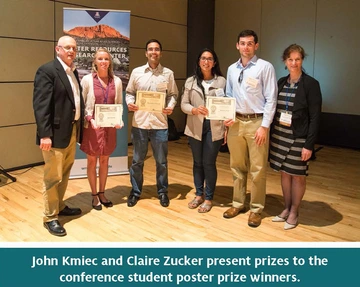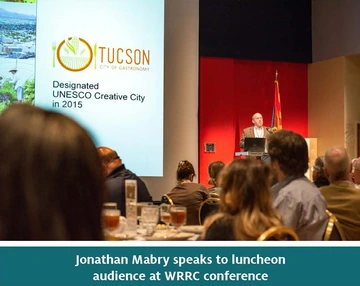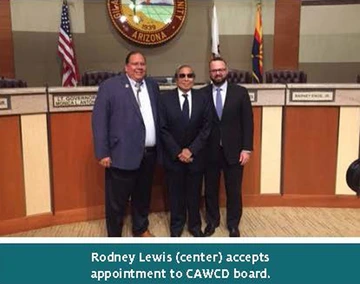Student Poster Prizes Awarded at 2017 WRRC Conference


At the March 28th conference, “Irrigated Agriculture in Arizona: A Fresh Perspective,” prizes were awarded for the best student posters. The poster exhibit included 14 posters on projects related to water management, quality, and irrigated agriculture. Of these, 11 were presented by students. While all the posters generated animated discussion during the event, three posters won top honors. First place went to graduate student Ravindra Dwivedi, Department of Hydrology and Atmospheric Sciences, for his poster, Catchment-scale Groundwater Recharge and Vegetation Water Use Efficiency. Juli Simons’ poster, Self-Sterilizing Irrigation Pipelines, took second place. Simons is a graduate student in the Department of Soil, Water, and Environmental Science. Innovative Water & Risk Trading Between Agriculture, Cities, Tribes & Conservation Interests by Suhina Deol, graduate student in the Department of Agricultural and Resource Economics, received third place honors. Poster sessions co-sponsors, Southern Arizona Water Users Association and Water Asset Management, provided funding for the prizes.
Apache Junction Receives Water Project of the Year Award
The Water Infrastructure Finance Authority (WIFA) of Arizona selected the Superstition Area Water Plant, which is operated by the Apache Junction Water Utilities Community Facilities District, as the recipient of the 2016 Drinking Water Project of the Year Award. The Superstition Area Water Plant was designed and built to treat 1.5 million gallons of water per day. WIFA’s Project of the Year awards recognize exemplary project management and commitment to public health through the improvement of drinking water and wastewater infrastructure.
Conference Lunch Celebrates Local Foods


Lunch at the WRRC’s 2017 annual conference, “Irrigated Agriculture in Arizona: A Fresh Perspective,” was a celebration of Tucson’s designation as a UNESCO City of Gastronomy, the first such designation in the United States. Dr. Jonathan Mabry, Historic Preservation Officer and Archaeologist for the City of Tucson, spoke about Tucson’s qualifications for the designation. Mabry, who was the lead author of the application to UNESCO, presented a tour of Tucson’s 4,000-year history of food production. Since 1993, archeological projects conducted in the floodplain of the Santa Cruz River have found irrigation canals that go back 3,500 years and uncovered an early farming village culture that flourished long before the Hohokam of the Phoenix area. In addition, Tucson has a 300-year tradition of vineyards, orchards and cattle ranching dating back to the Spanish period and currently has more foods listed on a worldwide list of regionally unique foods grown within 100 miles than any other city in North America. The designation is expected to encourage growth in tourism and related economic development.
As a special treat for the conference lunch, BKW Farms and master baker Don Guerra of Barrio Bread supplied each table with a basket of bread made from locally grown grain. The Wong family, owners of BKW Farms, grew the wheat—White Sonora, Khorasan, Hard Red, and Durum—Guerra used in his bread. This partnership illustrated the emergence of a unique local food culture in the Tucson
Goodyear and SRP Agree on Water Wheeling Deal
The City of Goodyear will finally be able to use its more than 17,000 acre-feet of water annually from CAP and a lease with the Gila River Indian Community, thanks to a unique agreement with the Salt River Project (SRP). Goodyear relies entirely on groundwater to meet its municipal water needs because it does not currently have the infrastructure necessary to use its annual CAP allocation. According to the agreement, SRP will wheel the water to Goodyear by taking delivery at the SRP-CAP Interconnect Facility near Granite Reef Dam and then transporting it through SRP’s conveyance system. Goodyear will pay SRP for the use of the interconnect facility and conveyance system. In addition, Goodyear will construct a water treatment plant and pipeline to connect the plant to the SRP system. Water deliveries to SRP shareholders from the Salt and Verde Rivers will not be affected. This partnership will increase Goodyear’s flexibility in planning for its future water demands, as well as create an opportunity for SRP to collaborate in regional water solutions.
USGS Studies Hualapai Basin Groundwater Declines
The City of Kingman and Mohave County are sponsoring a study of water use in the Hualapai Basin by the United States Geological Survey. The three-year study will cost $450,000, with the bill shared by the city and county. The study will be similar to one performed in the San Pedro Basin in Southern Arizona, using a groundwater flow model and groundwater monitoring through gravity network measurements from stations placed in the Hualapai Basin. The two-phase project will start with monitoring and end with modeling different scenarios of increased recharge and withdrawal of the basin to develop a picture of future groundwater levels. It is hoped that the new information will support decision making regarding potential water use regulation for the basin.
Rodney Lewis Appointed to CAWCD Board

Governor Doug Ducey announced the appointment of water rights attorney and Gila River Indian Community member Rodney Lewis to the 15-member Central Arizona Water Conservation District (CAWCD) Board of Directors. Governor Ducey noted Lewis’s long and distinguished service and experience as a valuable asset in the search for solutions to the complex issues faced by the CAWCD. Lewis, a graduate of the UCLA law school, served as the General Counsel for the Gila River Indian Community beginning in 1978 and led the Community’s negotiations with the federal government, the State of Arizona, and more than 30 non-Indian parties that resulted in the Arizona Water Settlements Act of 2004. He was the first member of an Arizona Indian Tribe to gain admission to the Arizona State Bar, and in 1980, he was the first member of an Indian Tribe to win a case before the United States Supreme Court. He also worked toward the Crow Nation Water Settlement of 2010 and the Pechanga Water Settlement of 2016. Lewis was inducted into the Maricopa County Bar’s Hall of Fame in 2009.
New Agreement Creates Partnership for Drought Resiliency
A cooperative agreement signed by the Gila River Indian Community, the Arizona Department of Water Resources, the City of Phoenix, and the Walton Family Foundation will support continued planning to address water level declines in Lake Mead. The agreement will allow Arizona parties to continue negotiating a comprehensive plan known as the Drought Contingency Plan Plus or DCP Plus. The partners seek to establish mechanisms for working together for the long-term protection of the Colorado River and Lake Mead.
Big Chino Sub-basin Groundwater Flow Modeling Study Undertaken
The City of Prescott, Town of Prescott Valley, and Salt River Project have partnered in an initiative to create a refined groundwater model for the Big Chino Sub-basin. The model’s purpose is to assess the hydrogeologic connection of sub-basin groundwater with the Upper Verde River and potential effects of plans to pump approximately 8,000 acre-feet of groundwater annually from sub-basin. In addition, hydrologic data collected over the past decade and continuing into the future will be augmented by information from newly installed groundwater and surface water monitoring stations. The 2010 US Geological Survey Northern Arizona Regional Groundwater Flow Model (NAGARFM), which encompassed the study area, was at too large a scale to be used for the needed level of detailed analysis to support decision-making. The refined modeling, to be carried out by Golder Associates, Inc. of Tucson, will be scaled to answer questions related to the effects of pumping in the Big Chino Sub-basin and what might be done to mitigate these effects if necessary. The $1.1 million effort is scheduled to be completed by 2020.

